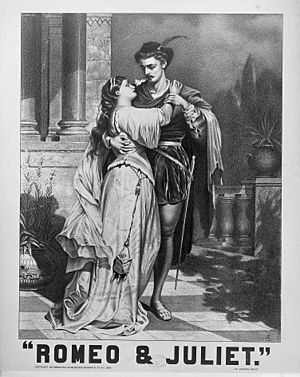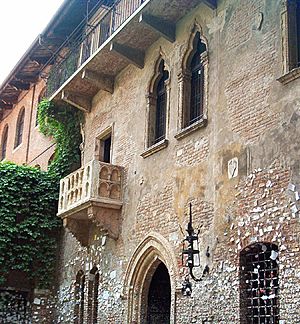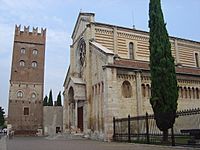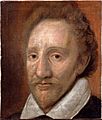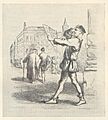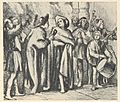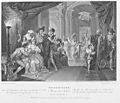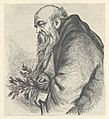Romeo and Juliet facts for kids
Romeo and Juliet is a play written by William Shakespeare. It is set in Italy and is about the love between two young people from noble families that are enemies. Romeo and Juliet has always been one of Shakespeare's most popular plays. It has been adapted to opera, ballet, television productions, and movies.
Contents
Characters

- Romeo Montague
- Juliet Capulet
- Nurse
- Mercutio
- Friar Laurence
- Tybalt
- Prince Escalus
- Lord and Lady Capulet
- Lord and Lady Montague
- Benvolio
Story
The noble families of the Montagues and the Capulets live in the city of Verona. They have had an argument, and are enemies. Their servants are enemies as well. The young men who work for the Montagues and the Capulets get into gangs and fight each other in the street. Because it is fashionable to carry a sword, sometimes they get badly injured.
Verona is ruled by Prince Escalus. He tells the Montagues and the Capulets that they have to stop fighting or they will be punished. It is very difficult to control the young men. Montague has only one child, a teenage boy called Romeo. Capulet also has only one child, a beautiful 14-year-old daughter called Juliet. They do not know each other, because Juliet never goes anywhere without her nursemaid. Romeo and his friends go to a masked ball at the home of Juliet's parents. Romeo and Juliet meet at a party and fall in love.
Because they think they will get into trouble with their parents, they try to hide their love by not talking about it at home. Juliet knows that her parents want her to marry a cousin of the prince. Romeo and Juliet get married in secret. Because of their secret marriage, a lot of things happen which bring about many deaths, including, finally, Romeo and Juliet kill themselves.
About the play
Because this play was written in the 1500s, the English language that it uses is not exactly like the English that is used today. Some of the play is written in poetry.
Language
- In modern English we say "you" for one person and also "you" for more than one person. But in Shakespeare's English, he often writes "thee" and "thou" when it means just one person.
- Juliet says "If they do see thee, they will murder thee!"
- Many words are used a little bit differently to the way they are used today, and other words are used that are now only used sometimes in poetry.
- Examples: "morn" for "morning; "morrow" for "tomorrow"; "woe" for "unhappiness".
Form
Romeo and Juliet, like many of Shakespeare's plays, is written in several different forms.
- Some of it is prose, which is like normal speaking. The servants in the play usually talk in prose.
- For example, two Capulet servants are planning to cause trouble with two Montague servants who are walking down the street.
- Sampson: "Let us take the law of our side! Let them begin!"
- Gregory: "I will frown as I pass by, and let them take it as they list!" (however they like)
- Sampson: "I will bite my thumb at them, which is a disgrace to them, if they bare it!"
- Some of the play is written in poetry which rhymes on the ends of the lines.
- For example, when Friar Laurence goes out to tend his garden in the early morning, he says:
- "The grey eyed Morn smiles on the frowning Night
- Checkering the eastern clouds with streaks of light."
- ("Morn" is used to mean morning in poetry)
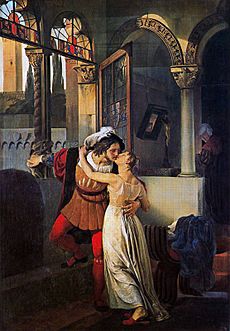
- A lot of poetry has rhyme and rhythm. But most of this play is written in a type of poetry called blank verse. This means that although it does not usually rhyme, it has strong rhythm. The rhythm is exactly the same in most of the play, and in many of Shakespeare's other plays. The rhythm goes:
-
- de-dah de-dah de-dah de-dah de-dah,
- de-dah de-dah de-dah de-dah de-dah.
- For example, Juliet, who is anxious to get a message from Romeo says:
- "The clock struck nine when I did send the nurse!
- In half an hour, she promised to return!"
- The play finishes with two lines that rhyme. This is called a rhyming couplet.
- The Prince says to Montague and Cauplet:
- "A glooming peace this morning with it brings;
- The sun for sorrow will not show his head.
- Go hence to have more talk of these sad things;
- Some shall be pardoned and some punish-ed:
- For never was a story of more woe
- Than this of Juliet and her Romeo."
-
-
- In simple English
-
The most famous scene
Of all the scenes that have ever been written in plays, one of the most famous is in Romeo and Juliet.
After Romeo and Juliet have met at a party and fallen in love, Juliet goes up to bed. But she cannot sleep so she stands at her window and pretends she is talking with Romeo.
- Romeo is going past and says "But soft, what light through yonder window breaks? ...It is my Lady! O, it is my Love!"
- Juliet, not knowing he is there, says "Romeo, Romeo, wherefore art thou Romeo?" (Romeo, Romeo, why do you have to be who you are?) She wishes he was not called Romeo Montague but had some different name, so he was not an enemy.
Romeo climbs up onto the balcony. Juliet tells Romeo that her love for him is as deep and endless as the sea. They part from each other with the famous words:
- "Good night! Good night! Parting is such sweet sorrow,
- That I shall say Good night till it be morrow." (tomorrow)
This romantic scene has been acted and copied many times, sometimes seriously and sometimes for fun. One well-known scene that took its idea from this, is from West Side Story, a musical by Leonard Bernstein, which takes place on a fire-escape landing with the lovers, Tony and Maria, singing the lovesong, Tonight.
Movies and music based on the play
Movies
Romeo and Juliet has been performed on stage many times. There have also been forty different movies
- 1908 - Romeo and Juliet, a silent movie was made by Vitagraph Studios in the US. Directed by J. Stuart Blackton, the movie starred Paul Panzer as Romeo and Florence Lawrence as Juliet.
- 1936 - Romeo and Juliet, produced by Irving Thalberg and directed by George Cukor of Classical Hollywood with Norma Shearer as Juliet and Leslie Howard as Romeo, but many critics said that the actors were too old.
- 1968 - Romeo and Juliet, directed by Franco Zeffirelli. This movie was made in Italy, with Olivia Hussey, who was 15, as Juliet and Leonard Whiting, who was 17, as Romeo. The costumes won an Oscar.
- 1996 - Romeo + Juliet, directed by Baz Luhrmann, with Leonardo DiCaprio as Romeo and Claire Danes as Juliet. This very colourful version has a modern setting.
- 2013 - Romeo + Juliet, directed by Carlo Carlei, with Douglas Booth as Romeo and Hailee Steinfeld as Juliet.
Adaptations
- 1950s - West Side Story, by Leonard Bernstein, is a musical set in a modern city in the US. It is about two rival street gangs, the J uyot ta yo juliet
Music
- 1839 - Berlioz wrote a symphony called Romeo and Juliet.
- 1867 - Gounod wrote an opera called Roméo et Juliette.
- 1869 - Tchaikovsky wrote a symphonic poem called Romeo and Juliet.
- 1936 - the first performance of Prokofiev's ballet, Romeo and Juliet.
- 1978 - Madero Richard. Costandinos, a French composer, wrote a disco opera titled Romeo & Juliet, which was released as a double album.
Images for kids
-
The title page from the First Folio, printed in 1623
-
Richard Burbage, probably the first actor to portray Romeo
-
Mary Saunderson, probably the first woman to play Juliet professionally
-
John Gielgud, who was among the more famous 20th-century actors to play Romeo, Friar Laurence and Mercutio on stage
-
In 2018, independent theater company Stairwell Theater presented Romeo & Juliet with a basketball theme
-
Romeo at Juliet's Deathbed, Henry Fuseli, 1809
-
Leslie Howard as Romeo and Norma Shearer as Juliet, in the 1936 MGM film directed by George Cukor
See also
 In Spanish: Romeo y Julieta para niños
In Spanish: Romeo y Julieta para niños


